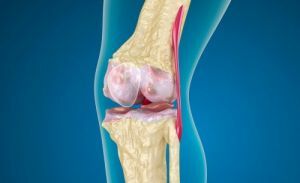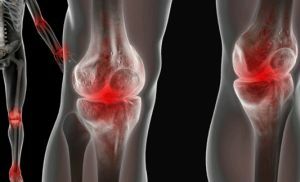 Hemarthrosis is a disease that is based on damage to joint tissues due to a hemorrhage into the joint cavity.
Hemarthrosis is a disease that is based on damage to joint tissues due to a hemorrhage into the joint cavity.
Most pathology is diagnosed in the knee joint, since the knee has a complex structure and is most prone to injury.
In addition to the traumatic factor, hemophilia plays a big role in the development of hemarthrosis - low coagulability of blood.
In this disease, hemorrhages occur very often. Gradually the capsule of the joint is stretched, which leads to a disruption of its functions. The knee swells, it becomes painful and restless.
Gemarthrosis is a fairly common disease. Most often it is diagnosed at the age of 25-45 years, but in patients with hemophilia it can appear already in 1-3 years. In old age, the cause of pathology is the weakness of the bones and muscles of the body.
Contents of the article
Contents of the article
- Causes and risk factors
- Symptoms of the disease
- Degrees of development of the pathology
- Diagnosis
- Methods of therapy
- Classical method
- Method two - advanced
- Folk methods
- Complications and consequences
- Rehabilitation
Causes and risk factors
The main cause of hemarthrosis of the kneeThe joints are injuries.
These can be patellar fractures, tears or sprains of the knee ligaments, bruises, meniscus lesions, dislocations, capsule fractures, vascular injuries. Each of these injuries can cause a hemorrhage into the joint cavity.
Another reason for the development of the disease is hemophilia. In this case, even the slightest impact on the knee leads to hemorrhages. Often, blood clots are formed spontaneously.
With the multiple entry of blood into the joint cavity, the process of destruction of the cartilage begins, which leads to the development of arthritis and arthrosis.
Doctors distinguish such risk factors for the development of the disease:
- intense physical activity;
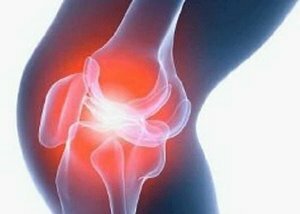
- occupation of a traumatic sport;
- presence of hemophilia;
- susceptibility to various types of hemorrhage;
- belongs to traumatic occupations.
The presence of two or more risk factors increases the likelihood of the disease several times.
Symptoms of the disease
In the case of damage to small blood vessels, blood seeps into the joint cavity.
Gradually the capsule of the joint is stretched, which leads to immobilization and severe pain. In addition to pain, doctors distinguish such symptoms of hemarthrosis:
- knee increase in size( sometimes for several hours);
- appearance of cones in front of the knee;
- smoothed knee contours;
- reddening of the skin - with damage to the capillaries, blueing - when a large vessel is ruptured;
- weakness in the knee;
- a feeling of softness and flaccidity when palpating the joint;
- increase in local temperature.
In the event that the cause of the disease is hemophilia, the symptoms for a long time may not be felt. The fact is that in the first stage of this pathology, blood clots are released in small amounts, so they are often not noticeable.
And only then, when the functions of ligaments and cartilaginous tissue are disrupted, pain appears, and the skin becomes crimson or cyanotic.
Degrees of development of pathology
 There are several classifications of the disease.
There are several classifications of the disease.
On clinical manifestations, hemarthrosis is divided into acute, chronic and recurrent, and due to complications, it is complicated and uncomplicated.
However, in medical practice, the classification by degrees of intraarticular lesions has become most widespread.
There are 3 degrees of hemarthrosis:
- I degree - characterized by the absence of any changes in the structure of the joint;
- II degree - proceeds with damages of soft tissues, joint capsule, meniscus, upper semilunar ligament, anterior cruciate ligament, fat suspension;
- III degree - differs by serious defects of the cartilage joint or bones. In this case, soft tissue damage can be absent.
Diagnosis
Diagnosis of the disease includes the mandatory use of MRI.This study makes it clear about the damage to blood vessels and soft tissues. As additional procedures, x-rays and ultrasound of the knee are prescribed.
So, by means of a roentgen establish presence of cracks or fracture of a bone.
Another mandatory way of diagnosing the disease is puncture of the joint cavity. If blood is found in the fluid, this is a serious sign of hemarthrosis, but if you find fat - a symptom of a fracture.
When small fragments are found, arthroscopy is performed, as a result of which bone fragments are removed and an accurate diagnosis is made.
Therapy Methods
The treatment of knee arthroplasty is aimed at removing blood, bone fragments and other unnecessary components from the joint cavity.
For this purpose, puncture and rinsing of the cavity is prescribed, and then drugs are introduced that eliminate the inflammatory process and reduce pain.
There are two ways to perform a puncture.
Classic method
A needle is inserted into the articular cavity and blood is sucked off. After the end of the procedure, a blood coagulation preparation, 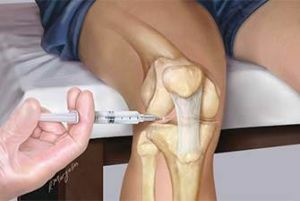 , anesthetics and anti-inflammatory drugs is injected into the joint.
, anesthetics and anti-inflammatory drugs is injected into the joint.
Then the knee is bandaged, a pressure bandage is applied, and the top is a plaster mold for immobilization. The disadvantage of this method is that when blood is sucked off in the joint cavity, a negative pressure is created, which contributes to the resumption or intensification of bleeding.
In addition, to extract all the blood to the end, usually fails, which is fraught with damage to ligaments and cartilage with antibodies. Such treatment is effective if the disease happened for the first time. Then the patients recover without relapse.
Method two - advanced
The second method is aimed at reducing the negative pressure in the joint cavity.
Its essence is as follows. The knee is squeezed with an elastic bandage, the needle is injected and most of the blood is sucked off. Then, a wash solution is introduced through the same needle. But they choose a medicine through another puncture. That is, during this procedure in the joint at the same time there are two needles.
Due to the formation of a higher rate of inflow of the solution than its outflow, a positive pressure forms.
When there is no blood in the sucked up liquid, the needle of the outflow is drawn, and another drug is injected through the other syringe.
Then, a pressure bandage is applied on the knee and immobilized using a gypsum longi.
If the disease occurred in a patient with hemophilia, he must be injected intravenously with antihemophilic globulin, and also prescribed a blood plasma transfusion. In case of neglected cases or chronic form of the disease, a surgical operation is performed.
Traditional methods of treatment
To remove pains in the joints and prevent repeated hemorrhage will help some recipes of traditional medicine:
- Take 1 spoon of herb oregano, nettle and yarrow and brew this collection of 0.7 liters of boiling water. Allow to stand for 1 hour. Tincture is drunk 50 g 3 times daily before meals.
- Mix half a spoonful of ammonia, 100 g of honey, 2 spoons of medical bile. The resulting cream is applied to the knee without rubbing it for 1 hour.
- Take the arnica grass, pour boiling water and let it swell. Then attach it to your knee and wrap it with gauze. Compress to hold 1 hour. Instead of arnica you can use chemist's clay or wormwood. They have a similar effect: they dissolve the tumor and eliminate bruising.
Complications and consequences
Over time, the blood cells that constantly accumulate in the joint cavity are disintegrating. As a result, a hemosiderin pigment is formed, which negatively affects the cartilage and capsule of the joint.
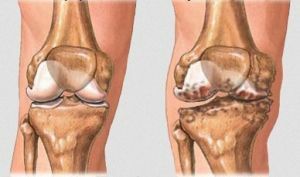 First they lose their elasticity, and then there is destruction. This leads to the immobilization of the knee and, as a consequence, to the disability of the patient.
First they lose their elasticity, and then there is destruction. This leads to the immobilization of the knee and, as a consequence, to the disability of the patient.
Another complication of hemarthrosis is the development of infectious diseases. The blood that is in the joint cavity is a very good medium for the reproduction of microbes.
Therefore, in the absence of proper treatment over time, there are infectious synovitis, bursitis, arthritis. They greatly complicate the process of treatment.
Recovery
Rehabilitation after medical or surgical treatment includes exercises for stretching the tendons, warming up the knee joint, resuming knee movements.
In addition, intensive physical activities and sports are excluded, sparing regimes are established.
Important in the process of recovery of the knee joint is proper nutrition. 
For example, with chronic hemarthrosis it is recommended to eat more spinach, young white cabbage, green onions, celery. These products increase blood coagulability, strengthen the walls of blood vessels, improve blood circulation.
Although knee hemarthrosis is a fairly common disease, its prognosis is usually favorable. Especially it concerns those cases when the cause of hemorrhage was trauma.
Then the probability of a favorable outcome is very high.
At the same time, relapse or a disease caused by hemophilia can lead to complications.
To prevent this, you need to reduce physical activity, establish a sparing regimen and monitor your lifestyle. If you adhere to these recommendations, the risk of complications will be significantly reduced.

